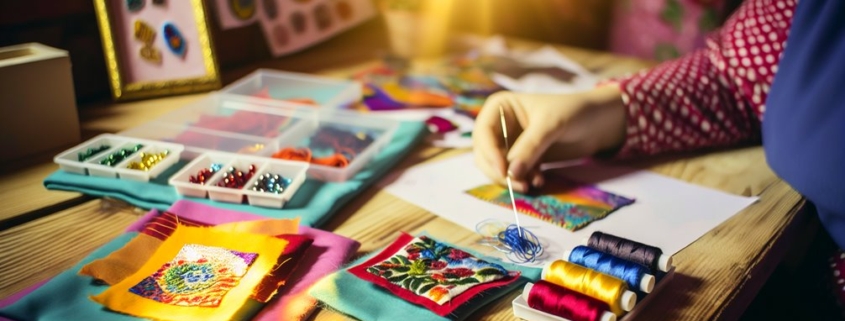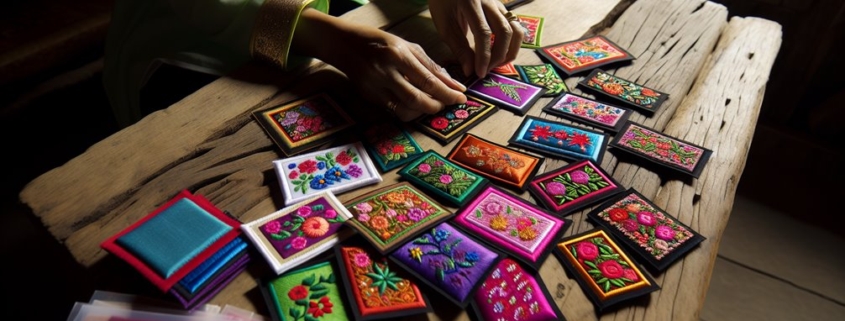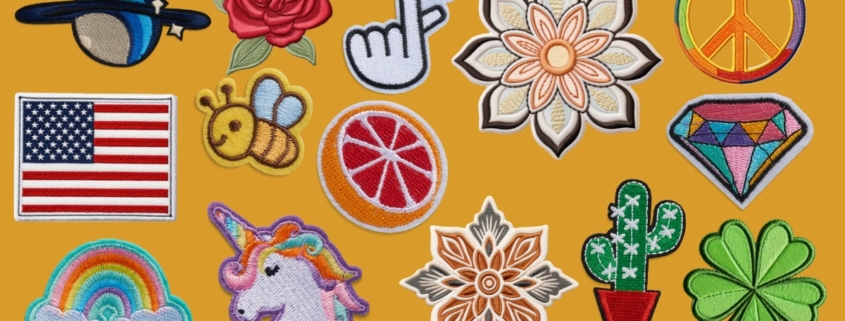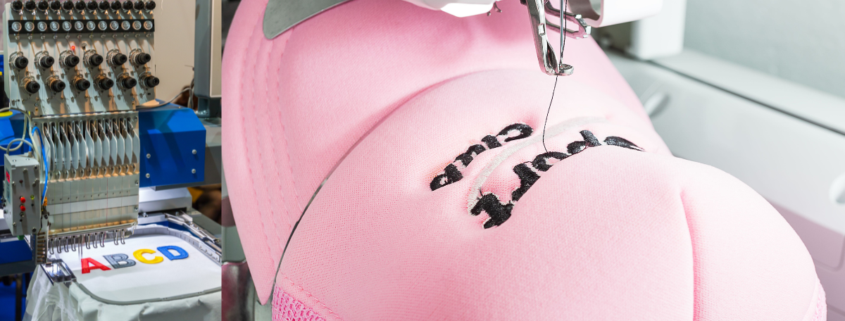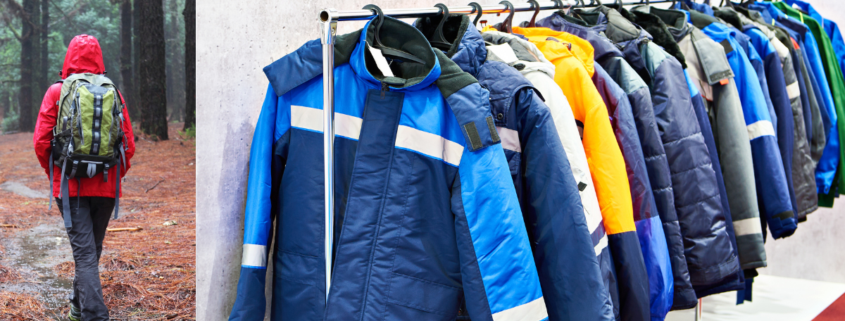Customizing name tags with embroidered patches begins with selecting a suitable base material—plastic for indoor use, metal for durability, or fabric for flexibility. Gather supplies such as quality twill or cotton patches, and verify surfaces are clean and smooth to promote adhesion. Choose designs that reflect personal style and enhance readability; consider the impact of colors and textures. Attach patches using heat-activated adhesives or fabric glue for initial placement and reinforce with stitching methods like satin or backstitch for durability. Proper care and storage are essential for maintaining your customized name tags, guaranteeing they make a lasting impression. Explore further to enhance your creation.
Here Is 5 Step Quick Recipe
- Select a name tag base material that complements the patch design and intended use.
- Choose embroidery patch designs that align with personal interests and ensure readability with color contrast.
- Properly prepare the name tag surface by cleaning and inspecting for imperfections before attaching patches.
- Employ adhesive techniques or stitching methods to attach patches, balancing durability and adjustability securely.
- Maintain and store customized name tags carefully to preserve their aesthetic quality and longevity.
Choosing Your Name Tag Base
Selecting the right base for name tags is important in customizing durable embroidered name tags. This choice greatly influences both the aesthetic appeal and the longevity of the name tag. Name tag materials are diverse, each designated to cater to different needs. Different names, different fonts, and name sizes are different too. Common options for base material include rubber for PVC, metal for pins, and fabric for flat embroidery. Plastic is lightweight and cost-effective, while metal provides a sleek, professional finish. Fabric bases, often used in embroidered patches, offer flexibility and a tactile quality.
When choosing name tag materials, consider the environment in which the name tag will be used. For instance, plastic may suffice for indoor events, but metal might be preferable for outdoor use due to its resilience. Additionally, the chosen material affects how color combinations appear. Metal can enhance bold, contrasting colors, while fabric allows for more subtle shading and blending.
Color combinations should be selected to guarantee readability and visual appeal. The base color should complement the embroidery to make the text stand out. By carefully considering these factors, you can create a name tag that not only meets functional requirements but also aligns aesthetically with personal or organizational identity.
Selecting Embroidery Patch Designs
Crafting a visually appealing and meaningful embroidery patch design is fundamental to the customization process of name tags. Selecting the right design and emb style requires both creativity and careful consideration. Design inspiration can stem from a variety of sources, including personal interests, organizational themes, or cultural symbols. It is vital to choose designs that resonate with the intended message or identity of the wearer. The choice of patch materials also plays an essential role in the design process, affecting both the aesthetics and durability of the final product.
When selecting embroidery patch designs, consider the following elements to guarantee a successful outcome:
- Color Palette: Choose colors that complement the name tag base and enhance readability.
- Symbolism: Incorporate meaningful symbols or icons that convey the desired message or affiliation.
- Text Style: Select fonts and text arrangements that maintain clarity and legibility.
Attention to these details guarantees that the embroidered patch not only enhances the visual appeal of the name tag but also effectively communicates the intended identity. By thoughtfully selecting embroidery patch designs, one can create a personalized and professional name tag that serves its purpose well, balancing aesthetics with functionality.
Gathering Necessary Supplies
Starting on the journey of creating custom name tags with embroidered patches requires a meticulous gathering of essential supplies to guarantee a smooth and efficient process. The first step is selecting high-quality patch materials. This includes choosing between different fabrics such as twill, felt, or cotton, each offering unique textures and durability. Consider the purpose of your name tag: will it endure frequent washes or just occasional use? This decision will guide your choice of material.
Next, you’ll need embroidery threads in various colors to bring your design inspiration to life. Opt for threads that complement your chosen fabric and align with your design’s color scheme. An embroidery machine, or a reliable needle if you’re hand-stitching, is indispensable for crafting the patches. Confirm you have the appropriate stabilizers and backing materials to maintain shape and prevent puckering.
Additionally, gather basic sewing supplies such as scissors, pins, and a ruler. Transfer materials like tracing paper are useful for lining your design onto the fabric. Finally, keep in mind the importance of an iron and ironing board for smooth finishing. With these supplies, you’re well-prepared to start transforming your creative concepts into vibrant, personalized name tags.
Preparing Your Name Tag Surface
A well-prepared surface is vital for the successful application of embroidered patches onto name tags. Proper surface preparation guarantees a seamless bond, resulting in a polished and professional appearance. Begin by selecting appropriate name tag materials, such as fabric, plastic, or metal, each of which requires distinct preparation techniques. Thoroughly cleaning the surface is essential; any dust, oils, or residues can compromise adhesion and result in a less durable outcome.
Consider the following steps to guarantee your name tag surface is ready for patch application:
- Inspect the name tag materials: Evaluate the surface for any irregularities or damage. Addressing any flaws beforehand will prevent complications later.
- Clean the surface meticulously: For fabric name tags, use a lint roller or gentle washing. Plastic and metal surfaces benefit from a mild cleanser and soft cloth.
- Dry thoroughly before proceeding: Moisture can lead to poor adhesion, so guarantee the surface is completely dry before attaching your patch.
These steps are foundational for achieving a successful customization of your name tags. By investing time in surface preparation, you enhance not only the aesthetic appeal but also the longevity of your customized name tags.
Attaching the Embroidered Patch
With the surface meticulously prepared, the next step in customizing your name tag is the precise attachment of the embroidered patch. Confirming proper patch alignment is essential for achieving a professional appearance. Begin by placing the patch on the name tag and adjusting its position until it aligns perfectly with the intended design layout. Careful attention to alignment at this stage can prevent the need for future corrections.
To adhere the patch, select from several adhesive options, each with distinct characteristics. Heat-activated adhesive, a popular choice, offers a durable bond when applied with an iron. In contrast, fabric glue provides a more flexible approach, allowing for slight adjustments before setting. Finally, adhesive sheets offer a no-mess solution, requiring only pressure to bond.
Adhesive Type | Application Method | Adjustability |
Heat-Activated | Ironing | Low |
Fabric Glue | Direct Application | Moderate |
Adhesive Sheets | Pressure-Based | High |
When applying any adhesive, follow the manufacturer’s instructions closely to confirm effectiveness and longevity. Be mindful of the material’s heat tolerance and adhesive compatibility to avoid damage. A well-attached patch not only enhances the name tag’s aesthetic but also adds a personalized touch that remains intact over time.
Securing the Patch With Stitching
Securing the patch with stitching provides an additional layer of durability and aesthetic appeal to the customized name tag. When choosing from various patch types, such as iron-on or sew-on, stitching remains a vital step to guarantee longevity. This process not only fortifies the attachment but also allows for creative expression through different stitching techniques. Selecting the appropriate technique is essential for maintaining the integrity of both the patch and the underlying fabric.
- Running stitch: A simple yet effective method, ideal for beginners, offering a clean look while securing the patch effectively.
- Satin stitch: Provides a polished and professional finish, often used to blend the edges of the patch seamlessly with the fabric.
- Backstitch: Offers a robust and durable solution, perfect for heavy-duty applications where the name tag must withstand wear and tear.
Each technique varies in complexity and suitability based on the patch type and the desired outcome. It’s important to take into account the fabric’s texture and the patch’s design to avoid puckering or distortion. By understanding these stitching techniques, one can enhance both the functionality and the visual appeal of the customized name tag, guaranteeing it stands the test of time.
Adding Personal Touches
Infusing name tags with personal touches transforms a simple accessory into a unique statement piece. Personalization ideas can range from selecting specific color schemes to incorporating motifs that resonate with the individual’s personality or interests. For instance, choosing a patch design that reflects a hobby, such as a musical note for a musician or a paintbrush for an artist, can convey a sense of identity and pride. Meanwhile, the addition of initials or names in specialized fonts offers a subtle yet impactful way to enhance the tag’s individuality.
Creative expressions through embroidered patches provide endless opportunities to showcase personal style while maintaining professional appeal. Consider experimenting with textures and fabrics; a velvet background or metallic threads can add sophistication and depth to the name tag. Incorporating symbols or icons that hold sentimental value, such as a cultural emblem or a family crest, further adds a layer of personal significance.
It is essential to guarantee that these elements are cohesive and do not overwhelm the overall design. Striking a balance between creativity and clarity guarantees that the name tag remains legible and serves its primary purpose effectively. Personal touches should enhance, not detract from, the name tag’s functionality and readability.
Caring for Your Customized Tags
As personalized name tags become cherished accessories, maintaining their longevity through proper care becomes paramount. Proper cleaning techniques and storing tips are essential to maintain the vibrancy and integrity of embroidered patches. Clean your customized tags with gentle care to avoid damage. Hand washing is preferable; use mild detergent and lukewarm water. Avoid harsh scrubbing as it may fray delicate threads and diminish the design’s vibrancy.
When storing your name tags, guarantee they are kept in a cool, dry place, away from direct sunlight and moisture, which can fade and warp the fabric over time. Consider these storing tips to protect your investment:
- Flat Storage: Lay tags flat in a drawer or box to prevent creasing and deformation.
- Use a Garment Bag: Store tags attached to clothing in a garment bag to protect them from dust and pests.
- Humidity Control: Utilize silica gel packets or a dehumidifier to maintain an ideal storage environment.
These practices will help preserve the aesthetic and functional qualities of your name tags. By adhering to these guidelines, you can guarantee that your personalized accessories remain pristine and continue to convey your unique identity for years to come.
Can Embroidered Patches Be Reused on Different Name Tags?
Embroidered patches can potentially be reused on different name tags, contingent upon the patch attachment method. Utilizing versatile attachment options, such as Velcro, enhances tag versatility, allowing for easy removal and reapplication without compromising the patch’s integrity.
What Types of Threads Are Best for Embroidered Patches?
When selecting thread types for embroidered patches, prioritize polyester and rayon threads. These materials enhance patch durability, offering resistance to fading and wear, ensuring longevity and maintaining vibrant colors throughout repeated use and wash cycles.
Are There Eco-Friendly Materials for Creating Embroidered Patches?
The demand for eco-friendly options in embroidered patches is rising, with sustainable practices focusing on organic cotton, recycled polyester threads, and natural dyes. These materials greatly reduce environmental impact while maintaining the quality and durability of traditional alternatives.
Can Embroidered Patches Be Made Waterproof?
Yes, embroidered patches can be made waterproof by incorporating a waterproof backing. This enhancement increases patch durability, ensuring longevity even in wet conditions, thereby maintaining their appearance and functionality across various applications and environments.


